sensor VOLVO XC90 TWIN ENGINE HYBRID 2017 Service Manual
[x] Cancel search | Manufacturer: VOLVO, Model Year: 2017, Model line: XC90 TWIN ENGINE HYBRID, Model: VOLVO XC90 TWIN ENGINE HYBRID 2017Pages: 584, PDF Size: 14.2 MB
Page 264 of 584
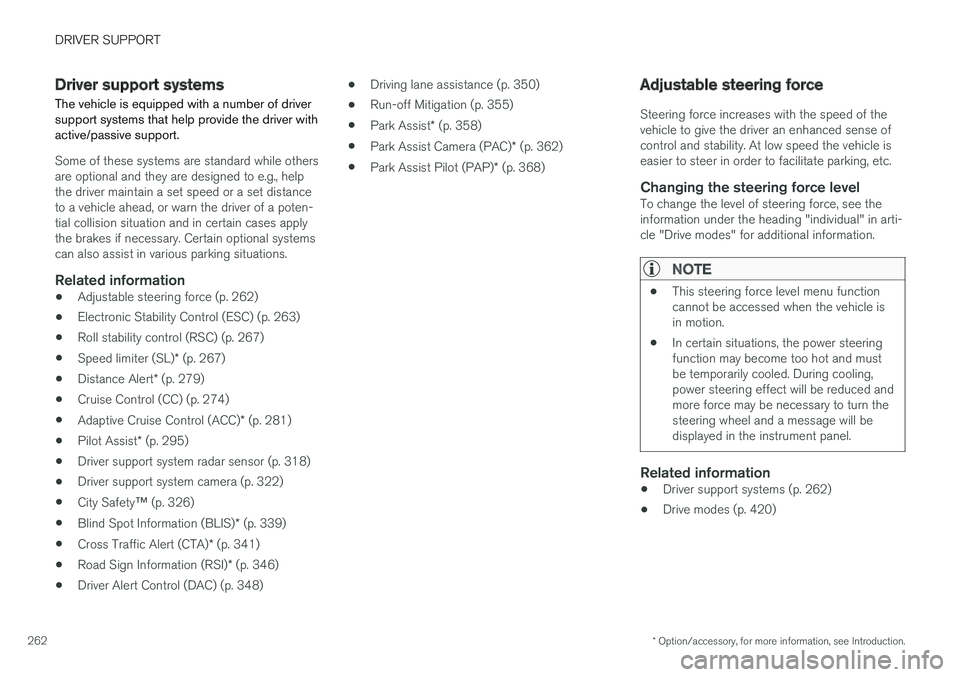
DRIVER SUPPORT
* Option/accessory, for more information, see Introduction.262
Driver support systems
The vehicle is equipped with a number of driversupport systems that help provide the driver withactive/passive support.
Some of these systems are standard while othersare optional and they are designed to e.g., helpthe driver maintain a set speed or a set distanceto a vehicle ahead, or warn the driver of a poten-tial collision situation and in certain cases applythe brakes if necessary. Certain optional systemscan also assist in various parking situations.
Related information
•Adjustable steering force (p. 262)
•Electronic Stability Control (ESC) (p. 263)
•Roll stability control (RSC) (p. 267)
•Speed limiter (SL)* (p. 267)
•Distance Alert* (p. 279)
•Cruise Control (CC) (p. 274)
•Adaptive Cruise Control (ACC)* (p. 281)
•Pilot Assist* (p. 295)
•Driver support system radar sensor (p. 318)
•Driver support system camera (p. 322)
•City Safety™ (p. 326)
•Blind Spot Information (BLIS)* (p. 339)
•Cross Traffic Alert (CTA)* (p. 341)
•Road Sign Information (RSI)* (p. 346)
•Driver Alert Control (DAC) (p. 348)
•Driving lane assistance (p. 350)
•Run-off Mitigation (p. 355)
•Park Assist* (p. 358)
•Park Assist Camera (PAC)* (p. 362)
•Park Assist Pilot (PAP)* (p. 368)
Adjustable steering force
Steering force increases with the speed of thevehicle to give the driver an enhanced sense ofcontrol and stability. At low speed the vehicle iseasier to steer in order to facilitate parking, etc.
Changing the steering force level
To change the level of steering force, see theinformation under the heading "individual" in arti-cle "Drive modes" for additional information.
NOTE
•This steering force level menu functioncannot be accessed when the vehicle isin motion.
•In certain situations, the power steeringfunction may become too hot and mustbe temporarily cooled. During cooling,power steering effect will be reduced andmore force may be necessary to turn thesteering wheel and a message will bedisplayed in the instrument panel.
Related information
•Driver support systems (p. 262)
•Drive modes (p. 420)
Page 269 of 584

DRIVER SUPPORT
}}
* Option/accessory, for more information, see Introduction.267
Roll stability control (RSC)
Volvo's Roll Stability Control (RSC) is a stabilitysystem designed to help minimize the risk of arollover in emergency maneuvers or if a skidshould occur.
RSC uses a gyroscopic sensor that registers theamount of change in the lateral angle at whichthe vehicle is leaning. Using this information, RSCcalculates the likelihood of a rollover. If there isan imminent risk of a rollover, the stability systemis activated, power to the engine is cut and thebrakes are applied to one or more of the wheelsuntil the vehicle regains stability.
WARNING
The vehicle
Page 283 of 584
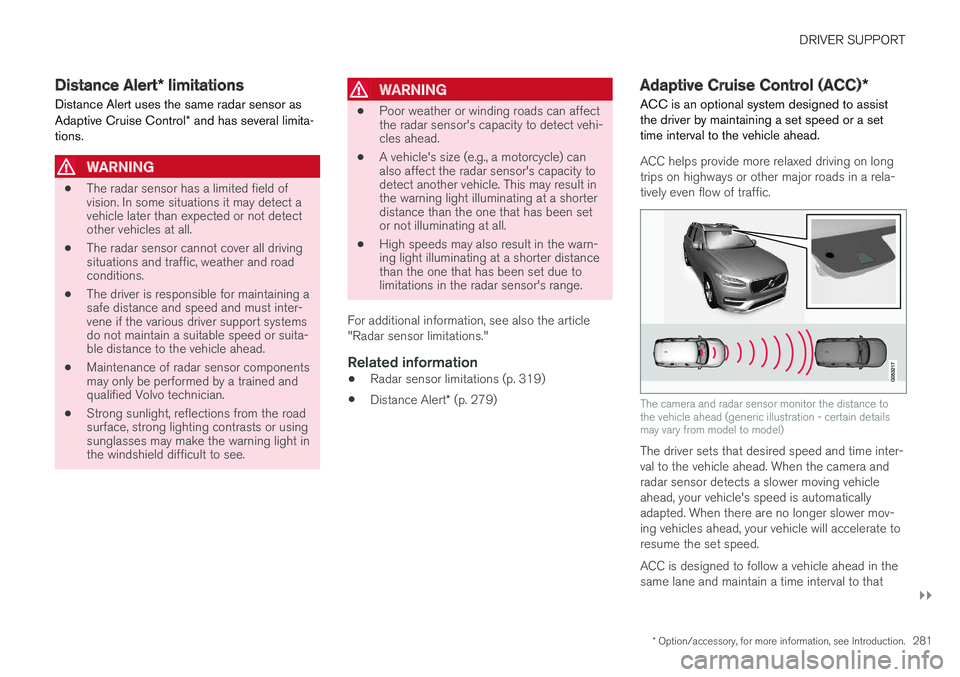
DRIVER SUPPORT
}}
* Option/accessory, for more information, see Introduction.281
Distance Alert* limitations
Distance Alert uses the same radar sensor asAdaptive Cruise Control* and has several limita-tions.
WARNING
•The radar sensor has a limited field ofvision. In some situations it may detect avehicle later than expected or not detectother vehicles at all.
•The radar sensor cannot cover all drivingsituations and traffic, weather and roadconditions.
•The driver is responsible for maintaining asafe distance and speed and must inter-vene if the various driver support systemsdo not maintain a suitable speed or suita-ble distance to the vehicle ahead.
•Maintenance of radar sensor componentsmay only be performed by a trained andqualified Volvo technician.
•Strong sunlight, reflections from the roadsurface, strong lighting contrasts or usingsunglasses may make the warning light inthe windshield difficult to see.
WARNING
•Poor weather or winding roads can affectthe radar sensor's capacity to detect vehi-cles ahead.
•A vehicle's size (e.g., a motorcycle) canalso affect the radar sensor's capacity todetect another vehicle. This may result inthe warning light illuminating at a shorterdistance than the one that has been setor not illuminating at all.
•High speeds may also result in the warn-ing light illuminating at a shorter distancethan the one that has been set due tolimitations in the radar sensor's range.
For additional information, see also the article"Radar sensor limitations."
Related information
•Radar sensor limitations (p. 319)
•Distance Alert* (p. 279)
Adaptive Cruise Control (ACC)*
ACC is an optional system designed to assistthe driver by maintaining a set speed or a settime interval to the vehicle ahead.
ACC helps provide more relaxed driving on longtrips on highways or other major roads in a rela-tively even flow of traffic.
The camera and radar sensor monitor the distance tothe vehicle ahead (generic illustration - certain detailsmay vary from model to model)
The driver sets that desired speed and time inter-val to the vehicle ahead. When the camera andradar sensor detects a slower moving vehicleahead, your vehicle's speed is automaticallyadapted. When there are no longer slower mov-ing vehicles ahead, your vehicle will accelerate toresume the set speed.
ACC is designed to follow a vehicle ahead in thesame lane and maintain a time interval to that
Page 284 of 584

||
DRIVER SUPPORT
282
vehicle set by the driver. If the radar sensor doesnot detect a vehicle ahead, ACC will insteadmaintain the speed set by the driver.
ACC is designed to smoothly regulate speed.However, the driver must apply the brakes in sit-uations that require immediate braking such aswhen there are great differences in speedbetween vehicles, or if the vehicle ahead brakessuddenly. Due to limitations in the radar sensor,braking may occur unexpectedly or not at all.
Adaptive Cruise Control can follow another vehi-cle from a standstill up to 125 mph (200 km/h).Always observe posted speed limits.
The driver can also toggle between ACC andCruise Control (CC) – see the article "Switchingbetween Cruise Control and Adaptive CruiseControl".
WARNING
•It is advisable to read through all of therelated articles pertaining to ACC (seethe list at the end of this article).
•Adaptive Cruise Control cannot cover alldriving situations and traffic, weather androad conditions.
•This system is designed to be a supple-mentary driving aid. It is not, however,intended to replace the driver's attentionand judgement. The driver is responsiblefor maintaining a safe distance and speedand must intervene if Adaptive CruiseControl does not maintain a suitablespeed or suitable distance to the vehicleahead.
•Maintenance of ACC components mayonly be performed by a trained and quali-fied Volvo technician.
Overview
The distance to the vehicle ahead (in the samelane) is monitored by a radar sensor. Your vehi-cle's speed is regulated by accelerating andbraking. The brakes may emit a sound when theyare being modulated by the adaptive cruise con-trol system. This is normal.
WARNING
•Adaptive Cruise Control is not a collisionavoidance system. The driver is alwaysresponsible for applying the brakes if thesystem does not detect another vehicle.
•Adaptive Cruise Control does not react topeople or animals, or small vehicles suchas bicycles and motorcycles. It also doesnot react to slow moving, parked orapproaching vehicles, or stationaryobjects.
•Do not use Adaptive Cruise Control indemanding driving conditions such as citydriving or other heavy traffic situations, inslippery conditions, when there is a greatdeal of water or slush on the road, duringheavy rain or snow, in poor visibility, onwinding roads or on highway on- or off-ramps.
Page 286 of 584

||
DRIVER SUPPORT
* Option/accessory, for more information, see Introduction.284
WARNING
Adaptive Cruise Control only warns of vehiclesdetected by the radar sensor. In some casesthere may be no warning or the warning maybe delayed. The driver should always apply thebrakes when necessary.
Head-up-display *
A flashing light alerts the driver
A flashing icon will appear in the head-up displayto alert the driver of a collision risk.
NOTE
Strong sunlight, reflections, extreme light con-trasts, the use of sunglasses, or if the driver isnot looking straight ahead may make the vis-ual warning signal in the windshield difficult tosee.
Related information
•Starting and activating Adaptive CruiseControl (ACC)* (p. 284)
•Changing Adaptive Cruise Control (ACC)speed (p. 287)
•Setting an Adaptive Cruise Control timeinterval (p. 288)
•Changing target vehicles and automaticbraking with Adaptive Cruise Control (ACC)(p. 289)
•Switching between Cruise Control andAdaptive Cruise Control* (p. 278)
•Passing Assistance with Adaptive CruiseControl or Pilot Assist-2 (p. 289)
•Deactivating/resuming Adaptive CruiseControl (ACC) (p. 285)
•Adaptive Cruise Control (ACC) - trouble-shooting (p. 291)
•Adaptive Cruise Control (ACC) symbols andmessages (p. 293)
•Pilot Assist* (p. 295)
•Distance Alert* (p. 279)
•Head-up display (HUD)* (p. 122)
•Radar sensor limitations (p. 319)
Starting and activating Adaptive
Cruise Control (ACC)*
ACC must first be put in active mode before itcan be started in order to regulate speed or aset time interval to the vehicle ahead.
Starting ACC (putting it in standby
mode)
Function buttons and symbols
–Press ◀ (2) or ▶ (3) to scroll to the ACC
() function. The symbol (4) will be dis-played in the instrument panel.
>The symbol indicates that ACC has beenstarted and is in standby mode. Instandby mode, the vehicle will not main-tain a set speed or a time interval to thevehicle ahead.
Page 288 of 584
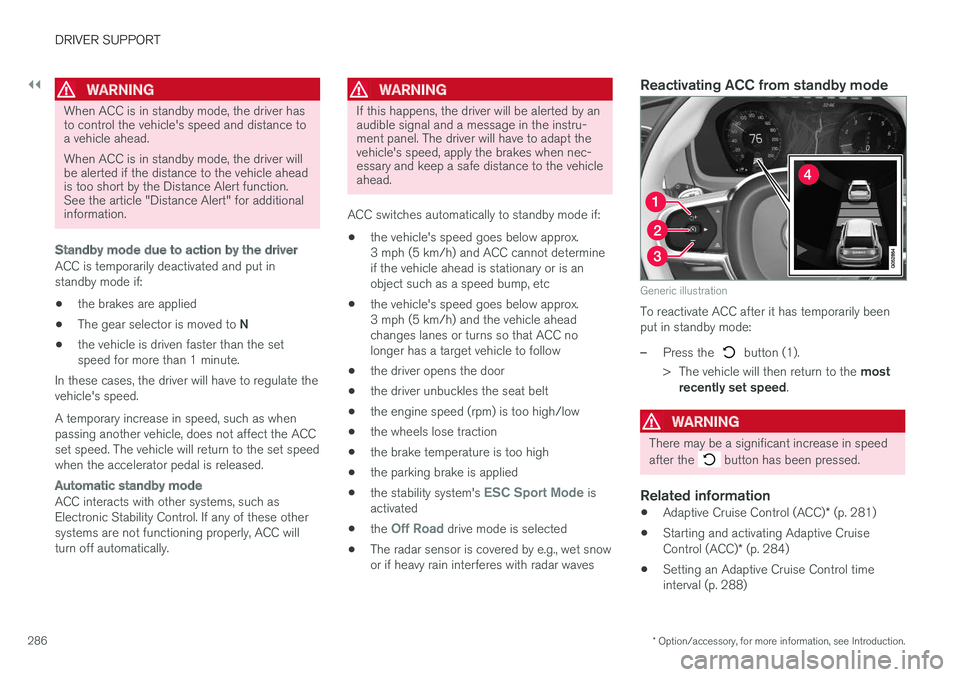
||
DRIVER SUPPORT
* Option/accessory, for more information, see Introduction.286
WARNING
When ACC is in standby mode, the driver hasto control the vehicle's speed and distance toa vehicle ahead.
When ACC is in standby mode, the driver willbe alerted if the distance to the vehicle aheadis too short by the Distance Alert function.See the article "Distance Alert" for additionalinformation.
Standby mode due to action by the driver
ACC is temporarily deactivated and put instandby mode if:
•the brakes are applied
•The gear selector is moved to N
•the vehicle is driven faster than the setspeed for more than 1 minute.
In these cases, the driver will have to regulate thevehicle's speed.
A temporary increase in speed, such as whenpassing another vehicle, does not affect the ACCset speed. The vehicle will return to the set speedwhen the accelerator pedal is released.
Automatic standby mode
ACC interacts with other systems, such asElectronic Stability Control. If any of these othersystems are not functioning properly, ACC willturn off automatically.
WARNING
If this happens, the driver will be alerted by anaudible signal and a message in the instru-ment panel. The driver will have to adapt thevehicle's speed, apply the brakes when nec-essary and keep a safe distance to the vehicleahead.
ACC switches automatically to standby mode if:
•the vehicle's speed goes below approx.3 mph (5 km/h) and ACC cannot determineif the vehicle ahead is stationary or is anobject such as a speed bump, etc
•the vehicle's speed goes below approx.3 mph (5 km/h) and the vehicle aheadchanges lanes or turns so that ACC nolonger has a target vehicle to follow
•the driver opens the door
•the driver unbuckles the seat belt
•the engine speed (rpm) is too high/low
•the wheels lose traction
•the brake temperature is too high
•the parking brake is applied
•the stability system's ESC Sport Mode isactivated
•the Off Road drive mode is selected
•The radar sensor is covered by e.g., wet snowor if heavy rain interferes with radar waves
Reactivating ACC from standby mode
Generic illustration
To reactivate ACC after it has temporarily beenput in standby mode:
–Press the button (1).
>The vehicle will then return to the mostrecently set speed.
WARNING
There may be a significant increase in speed
after the button has been pressed.
Related information
•Adaptive Cruise Control (ACC)* (p. 281)
•Starting and activating Adaptive CruiseControl (ACC)* (p. 284)
•Setting an Adaptive Cruise Control timeinterval (p. 288)
Page 293 of 584
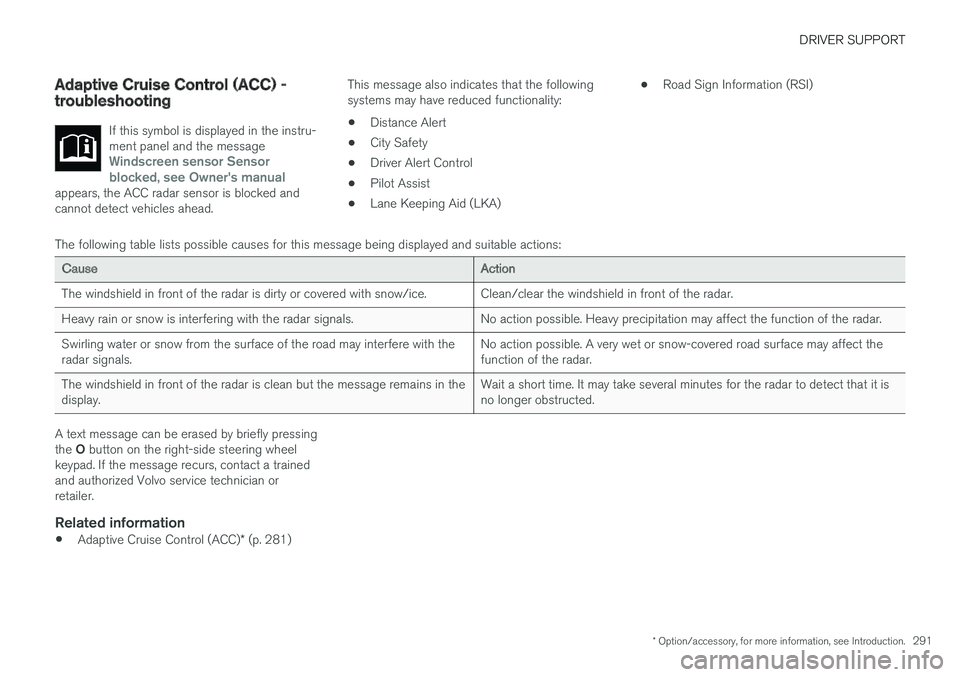
DRIVER SUPPORT
* Option/accessory, for more information, see Introduction.291
Adaptive Cruise Control (ACC) -troubleshooting
If this symbol is displayed in the instru-ment panel and the messageWindscreen sensor Sensorblocked, see Owner's manualappears, the ACC radar sensor is blocked andcannot detect vehicles ahead.
This message also indicates that the followingsystems may have reduced functionality:
•Distance Alert
•City Safety
•Driver Alert Control
•Pilot Assist
•Lane Keeping Aid (LKA)
•Road Sign Information (RSI)
The following table lists possible causes for this message being displayed and suitable actions:
CauseAction
The windshield in front of the radar is dirty or covered with snow/ice.Clean/clear the windshield in front of the radar.
Heavy rain or snow is interfering with the radar signals.No action possible. Heavy precipitation may affect the function of the radar.
Swirling water or snow from the surface of the road may interfere with theradar signals.No action possible. A very wet or snow-covered road surface may affect thefunction of the radar.
The windshield in front of the radar is clean but the message remains in thedisplay.Wait a short time. It may take several minutes for the radar to detect that it isno longer obstructed.
A text message can be erased by briefly pressingthe O button on the right-side steering wheelkeypad. If the message recurs, contact a trainedand authorized Volvo service technician orretailer.
Related information
•Adaptive Cruise Control (ACC)* (p. 281)
Page 294 of 584
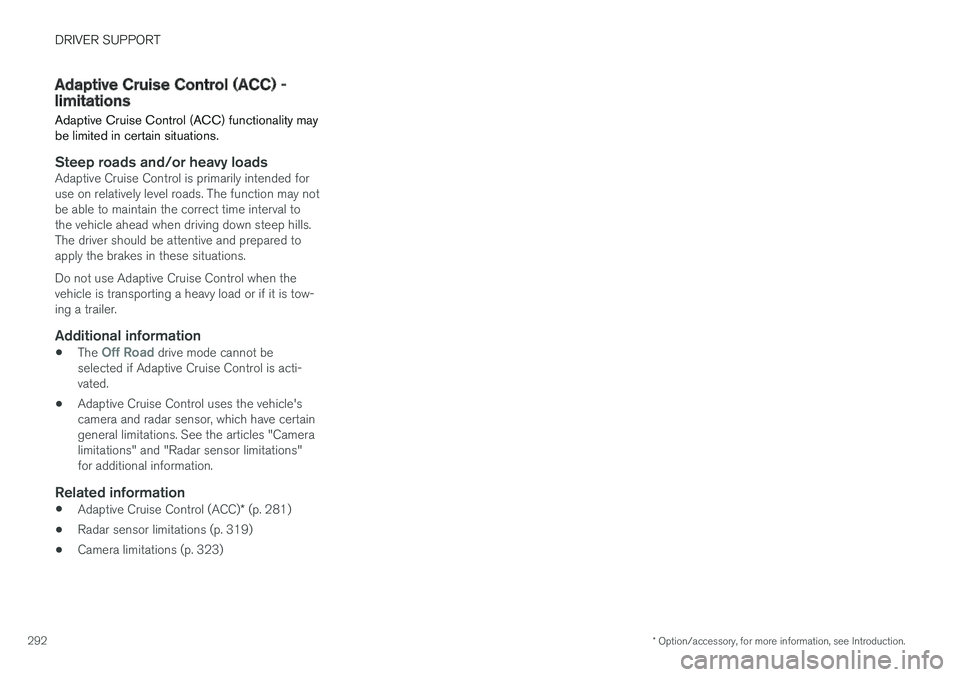
DRIVER SUPPORT
* Option/accessory, for more information, see Introduction.292
Adaptive Cruise Control (ACC) -limitations
Adaptive Cruise Control (ACC) functionality maybe limited in certain situations.
Steep roads and/or heavy loads
Adaptive Cruise Control is primarily intended foruse on relatively level roads. The function may notbe able to maintain the correct time interval tothe vehicle ahead when driving down steep hills.The driver should be attentive and prepared toapply the brakes in these situations.
Do not use Adaptive Cruise Control when thevehicle is transporting a heavy load or if it is tow-ing a trailer.
Additional information
•The Off Road drive mode cannot beselected if Adaptive Cruise Control is acti-vated.
•Adaptive Cruise Control uses the vehicle'scamera and radar sensor, which have certaingeneral limitations. See the articles "Cameralimitations" and "Radar sensor limitations"for additional information.
Related information
•Adaptive Cruise Control (ACC)* (p. 281)
•Radar sensor limitations (p. 319)
•Camera limitations (p. 323)
Page 296 of 584

||
DRIVER SUPPORT
* Option/accessory, for more information, see Introduction.294
SymbolMessageExplanation
Adaptive cruise
Service required
The system is not functioning properly. Contact a trained and qualified Volvo Service tech-nician.
Windscreen sensor Sensor blocked, seeOwner's manualClean the windshield in front of the camera/radar sensor.
A text message can be erased by briefly pressingthe O button on the right-side steering wheelkeypad. If the message recurs, contact a trainedand authorized Volvo service technician orretailer.
Related information
•Adaptive Cruise Control (ACC)* (p. 281)
•Road Sign Information (RSI)* (p. 346)
Page 297 of 584
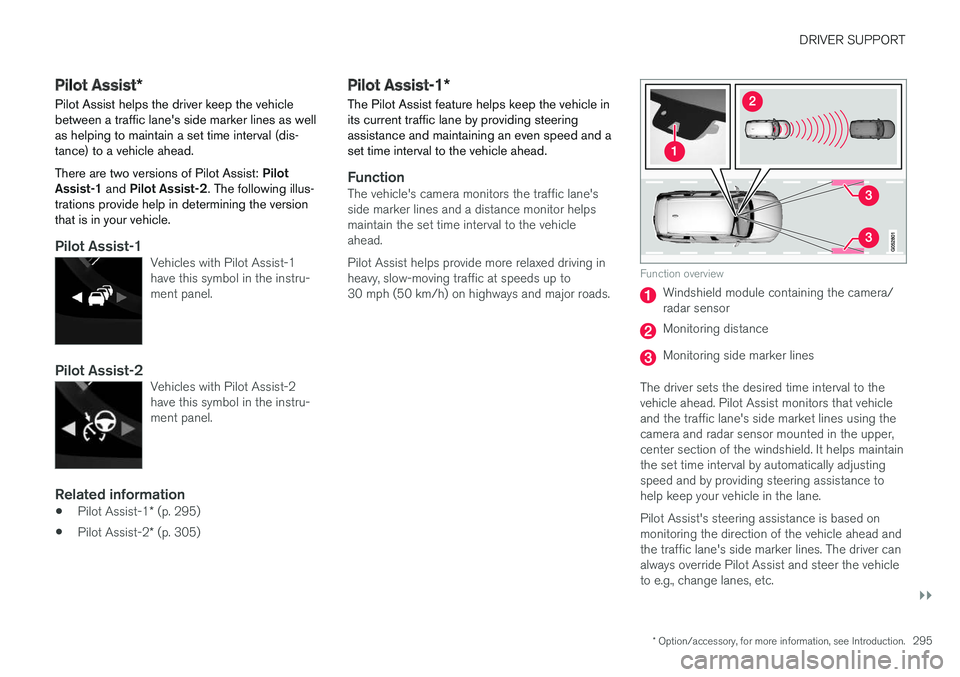
DRIVER SUPPORT
}}
* Option/accessory, for more information, see Introduction.295
Pilot Assist*
Pilot Assist helps the driver keep the vehiclebetween a traffic lane's side marker lines as wellas helping to maintain a set time interval (dis-tance) to a vehicle ahead.
There are two versions of Pilot Assist: PilotAssist-1 and Pilot Assist-2. The following illus-trations provide help in determining the versionthat is in your vehicle.
Pilot Assist-1
Vehicles with Pilot Assist-1have this symbol in the instru-ment panel.
Pilot Assist-2
Vehicles with Pilot Assist-2have this symbol in the instru-ment panel.
Related information
•Pilot Assist-1* (p. 295)
•Pilot Assist-2* (p. 305)
Pilot Assist-1*
The Pilot Assist feature helps keep the vehicle inits current traffic lane by providing steeringassistance and maintaining an even speed and aset time interval to the vehicle ahead.
Function
The vehicle's camera monitors the traffic lane'sside marker lines and a distance monitor helpsmaintain the set time interval to the vehicleahead.
Pilot Assist helps provide more relaxed driving inheavy, slow-moving traffic at speeds up to30 mph (50 km/h) on highways and major roads.
Function overview
Windshield module containing the camera/radar sensor
Monitoring distance
Monitoring side marker lines
The driver sets the desired time interval to thevehicle ahead. Pilot Assist monitors that vehicleand the traffic lane's side market lines using thecamera and radar sensor mounted in the upper,center section of the windshield. It helps maintainthe set time interval by automatically adjustingspeed and by providing steering assistance tohelp keep your vehicle in the lane.
Pilot Assist's steering assistance is based onmonitoring the direction of the vehicle ahead andthe traffic lane's side marker lines. The driver canalways override Pilot Assist and steer the vehicleto e.g., change lanes, etc.